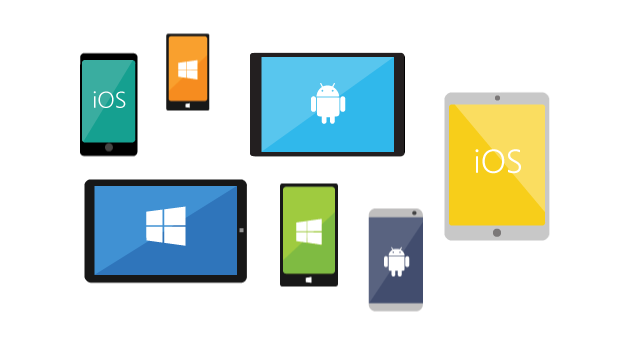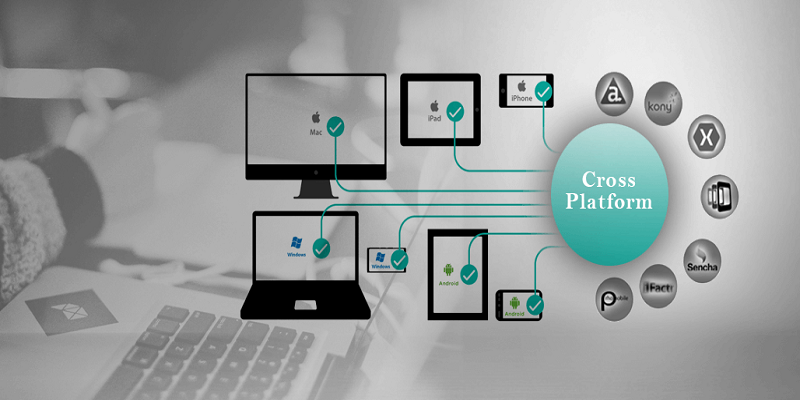Introduction
In today’s fast-paced digital landscape, staying ahead of the curve is essential for success in app development. One of the key strategies driving innovation and efficiency in this field is the adoption of cross-platform technology. By leveraging cross-platform frameworks and tools, developers can streamline the app development process, reduce time to market, and reach a wider audience with their applications.

Cross-platform technology allows developers to write code once and deploy it across multiple platforms, such as iOS, Android, and even web browsers. This approach offers several advantages over traditional platform-specific development:
Table of Contents
Cost Efficiency:
Developing separate codebases for each platform can be expensive and time-consuming. Cross-platform development significantly reduces development costs by allowing developers to write code once and deploy it across multiple platforms, thereby saving time and resources.
Faster Time to Market:
With cross-platform development, developers can build and deploy apps more quickly than with traditional development methods. By writing code once and deploying it across multiple platforms, developers can accelerate the app development lifecycle and get their products to market faster.
Broader Reach:
Cross-platform apps can reach a wider audience by targeting multiple platforms simultaneously. Instead of developing separate apps for iOS and Android, developers can create a single app that works across both platforms, as well as on web browsers. This broadens the app’s potential user base and maximizes its impact.
Consistent User Experience:
Cross-platform frameworks and tools enable developers to maintain a consistent user experience across different platforms. By using a single codebase, developers can ensure that the app looks and functions the same way on iOS, Android, and web browsers, providing a seamless experience for users.
Easier Maintenance:
Managing multiple codebases for different platforms can be challenging and time-consuming. Cross-platform development simplifies maintenance by allowing developers to update the codebase once and deploy the changes across all platforms simultaneously. This streamlines the maintenance process and reduces the risk of inconsistencies or bugs.
As technology continues to evolve, cross-platform development will play an increasingly important role in the future of app development. By embracing cross-platform frameworks and tools, developers can stay ahead of the curve, streamline their development processes, and deliver high-quality apps to a global audience.
The Rise of Cross-Platform Development
Cross-platform development has gained significant traction in recent years due to the increasing demand for mobile applications across different platforms. With the proliferation of smartphones and tablets running on various operating systems, developers face the challenge of reaching a diverse user base while minimizing development costs and time to market.

Traditionally, developers had to choose between native development, which involves writing separate codebases for each platform (e.g., Objective-C or Swift for iOS, Java or Kotlin for Android), or web-based development, which relies on technologies like HTML, CSS, and JavaScript for building mobile web apps. While native development offers optimal performance and access to platform-specific features, it requires significant time and resources to maintain multiple codebases. On the other hand, web-based development simplifies cross-platform compatibility but may sacrifice performance and access to device capabilities.
Cross-platform development emerged as a middle ground between native and web-based approaches, offering the best of both worlds. By using cross-platform frameworks and tools, developers can write code once and deploy it across multiple platforms, combining the efficiency of web development with the performance and native-like experience of traditional apps.
Key Technologies in Cross-Platform Development
Several cross-platform frameworks and tools have emerged to facilitate the development of cross-platform apps. These frameworks abstract away platform-specific complexities and provide developers with a unified environment for building and deploying apps across multiple platforms. Some of the most popular cross-platform technologies include:

React Native:
Developed by Facebook, React Native is an open-source framework for building cross-platform mobile apps using JavaScript and React. It allows developers to create native-like user interfaces and access platform-specific features while sharing a single codebase across iOS and Android.
Flutter:
Developed by Google, Flutter is an open-source UI toolkit for building natively compiled applications for mobile, web, and desktop from a single codebase. It uses the Dart programming language and provides a rich set of pre-built widgets for creating beautiful, fast, and customizable user interfaces.
Xamarin:
Owned by Microsoft, Xamarin is a cross-platform framework for building native mobile apps using C# and .NET. It enables developers to share code across iOS, Android, and Windows platforms while providing full access to platform-specific APIs and native performance.
Ionic:
Built on top of Angular and Apache Cordova, Ionic is a popular open-source framework for building cross-platform mobile apps using web technologies such as HTML, CSS, and JavaScript. It offers a rich set of UI components, pre-built themes, and native-like performance through Cordova plugins.
NativeScript:
Developed by Progress Software, NativeScript is an open-source framework for building cross-platform native mobile apps using JavaScript, TypeScript, or Angular. It provides direct access to native APIs and UI components, allowing developers to create highly performant and visually appealing apps.
These cross-platform frameworks and tools empower developers to build high-quality apps with a consistent user experience across different platforms. By abstracting away platform-specific complexities and providing a unified development environment, these technologies enable faster development cycles, easier maintenance, and broader reach for mobile applications.
Advantages of Cross-Platform Development
The adoption of cross-platform development offers several advantages for developers, businesses, and end-users alike:
Cost Savings:
Cross-platform development reduces the time and resources required to build and maintain mobile apps by allowing developers to write code once and deploy it across multiple platforms. This results in lower development costs and faster time to market, making it an attractive option for businesses with limited budgets and tight deadlines.
Faster Time to Market:
By leveraging cross-platform frameworks and tools, developers can accelerate the app development lifecycle and get their products to market faster. With a single codebase for multiple platforms, developers can iterate quickly, address feedback from users, and release updates more frequently, keeping pace with changing market demands.
Broader Reach:
Cross-platform apps can reach a wider audience by targeting multiple platforms simultaneously. Instead of developing separate apps for iOS and Android, developers can create a single app that works across both platforms, as well as on web browsers. This broadens the app’s potential user base and maximizes its impact in the market.
Consistent User Experience:
Cross-platform frameworks and tools enable developers to maintain a consistent user experience across different platforms. By using a single codebase, developers can ensure that the app looks and functions the same way on iOS, Android, and web browsers, providing a seamless experience for users regardless of the device they are using.
Easier Maintenance:
Managing multiple codebases for different platforms can be challenging and time-consuming. Cross-platform development simplifies maintenance by allowing developers to update the codebase once and deploy the changes across all platforms simultaneously. This streamlines the maintenance process and reduces the risk of inconsistencies or bugs, ensuring a smoother user experience.
Challenges and Considerations
While cross-platform development offers many benefits, it also presents some challenges and considerations that developers need to be aware of:
Performance:
While cross-platform frameworks strive to provide native-like performance, there may still be some performance overhead compared to native development. Developers need to carefully optimize their code and leverage platform-specific optimizations to ensure that their apps meet performance expectations, especially for resource-intensive tasks such as graphics rendering and animations.
Platform Limitations:
Cross-platform development may impose certain limitations on access to platform-specific features and APIs. While most cross-platform frameworks provide access to a wide range of native APIs, there may be cases where developers need to implement custom solutions or workarounds to achieve specific functionality on each platform.
Tooling and Ecosystem:
The availability of tools, libraries, and resources may vary across different cross-platform frameworks. Developers need to evaluate the ecosystem surrounding each framework and choose the one that best aligns with their requirements and preferences. Additionally, keeping up with updates and changes to the framework’s ecosystem is essential to leverage new features and improvements.
Learning Curve:
While cross-platform frameworks aim to simplify the development process, there is still a learning curve involved in mastering the framework’s concepts, APIs, and best practices. Developers may need to invest time in training and experimentation to become proficient in cross-platform development, especially if they are transitioning from native or web-based development.
Vendor Lock-in:
Depending on the chosen cross-platform framework, developers may become dependent on a particular vendor or technology stack. This can limit flexibility and portability in the long run, especially if the vendor discontinues support for the framework or introduces significant changes that affect existing applications. Developers should carefully evaluate the long-term implications of vendor lock-in and consider alternative solutions to mitigate risks.
By addressing these challenges and considerations, developers can make informed decisions about adopting cross-platform development and maximize the benefits it offers for their projects.
Future Trends in Cross-Platform Development
Looking ahead, several trends are shaping the future of cross-platform development and influencing the evolution of frameworks and tools:
Hybrid Approaches:
Hybrid approaches that combine the strengths of cross-platform and native development are gaining popularity. Technologies like React Native and Xamarin allow developers to build cross-platform apps while integrating platform-specific code and components for optimal performance and user experience.
Progressive Web Apps (PWAs):
Progressive Web Apps (PWAs) are web-based applications that leverage modern web technologies to deliver app-like experiences across different devices and platforms. PWAs offer benefits such as offline access, push notifications, and installation prompts, blurring the lines between web and native apps and providing a compelling alternative to traditional app development.
Machine Learning and AI:
Machine learning and artificial intelligence are increasingly being integrated into cross-platform development frameworks to enable intelligent features and capabilities in mobile apps. Frameworks like TensorFlow Lite and ML Kit provide pre-trained models and APIs for tasks such as image recognition, natural language processing, and predictive analytics, empowering developers to create smarter and more personalized experiences for users.
Cross-Platform Design Systems:
Design systems that provide consistent UI components and patterns across different platforms are becoming essential for cross-platform development. Frameworks like Material Design and Fluent Design System offer guidelines, tools, and pre-built components for creating visually cohesive and user-friendly interfaces that adapt to different devices and screen sizes.
Low-Code and No-Code Development:
Low-code and no-code development platforms are simplifying the app development process by enabling users with limited technical expertise to build mobile apps without writing code. These platforms offer visual interfaces, drag-and-drop tools, and pre-built templates for designing and deploying apps, democratizing access to app development and accelerating time to market.
By embracing these trends and advancements, developers can stay at the forefront of cross-platform development and leverage emerging technologies to create innovative and impactful mobile apps.
Conclusion
Cross-platform development has revolutionized the way mobile apps are built, offering a cost-effective, efficient, and scalable approach to reaching a diverse audience across multiple platforms. By leveraging cross-platform frameworks and tools, developers can streamline the development process, reduce time to market, and deliver high-quality apps with a consistent user experience.
As technology continues to evolve, cross-platform development will play an increasingly important role in the future of app development. By staying ahead of the curve and embracing emerging trends and advancements, developers can capitalize on the opportunities offered by cross-platform development and create innovative and impactful mobile apps that resonate with users worldwide. For more information, so please visit this link.
Frequently Asked Questions (FAQs) about Cross-Platform App Development:
1. What is cross-platform app development?
Cross-platform app development refers to the process of creating mobile applications that can run on multiple operating systems, such as iOS, Android, and sometimes even web browsers, using a single codebase. This approach allows developers to write code once and deploy it across different platforms, thereby saving time and resources.
2. What are the benefits of cross-platform app development?
Cross-platform app development offers several benefits, including cost efficiency, faster time to market, broader reach, consistent user experience across platforms, and easier maintenance. By leveraging cross-platform frameworks and tools, developers can streamline the development process and deliver high-quality apps to a wider audience.
3. What are some popular cross-platform frameworks and tools?
Some popular cross-platform frameworks and tools include React Native, Flutter, Xamarin, Ionic, and NativeScript. These frameworks provide developers with a unified environment for building and deploying apps across multiple platforms, using languages such as JavaScript, Dart, C#, and TypeScript.
4. How does cross-platform development compare to native development?
Cross-platform development offers advantages such as cost savings, faster time to market, and broader reach compared to native development, which involves writing separate codebases for each platform. While native development may offer better performance and access to platform-specific features, cross-platform development provides a more efficient and scalable approach for reaching a diverse audience.
5. What are some challenges of cross-platform app development?
Challenges of cross-platform app development include performance considerations, platform limitations, tooling and ecosystem differences, the learning curve associated with mastering cross-platform frameworks, and the risk of vendor lock-in. Developers need to carefully evaluate these challenges and considerations when choosing cross-platform development for their projects.
6. Can cross-platform apps achieve the same level of performance as native apps?
While cross-platform frameworks strive to provide native-like performance, there may still be some performance overhead compared to native development. However, with careful optimization, leveraging platform-specific optimizations, and using performance profiling tools, developers can achieve satisfactory performance for most mobile applications.
7. How can I choose the right cross-platform framework for my project?
When choosing a cross-platform framework for your project, consider factors such as programming language preference, ecosystem support, performance requirements, access to platform-specific features, community support, and long-term scalability. It’s essential to evaluate multiple frameworks, conduct research, and consider your project’s specific needs before making a decision.
8. Are there any limitations to cross-platform app development?
Cross-platform app development may impose limitations on access to platform-specific features and APIs, as well as performance considerations compared to native development. Additionally, the choice of cross-platform framework may introduce dependencies and constraints that affect long-term flexibility and portability. Developers should carefully evaluate these limitations and consider alternative solutions to mitigate risks.
9. How can I ensure a consistent user experience across different platforms?
To ensure a consistent user experience across different platforms, leverage cross-platform frameworks and tools that provide built-in support for UI components, layout systems, and navigation patterns. Additionally, follow platform-specific design guidelines and best practices to adapt your app’s interface and behavior to each platform while maintaining a cohesive overall experience.
10. What is the future outlook for cross-platform app development?
The future outlook for cross-platform app development is promising, with continued advancements in frameworks, tools, and technologies aimed at improving developer productivity, app performance, and user experience. As the demand for mobile apps grows and technology evolves, cross-platform development will play an increasingly important role in shaping the future of app development.
